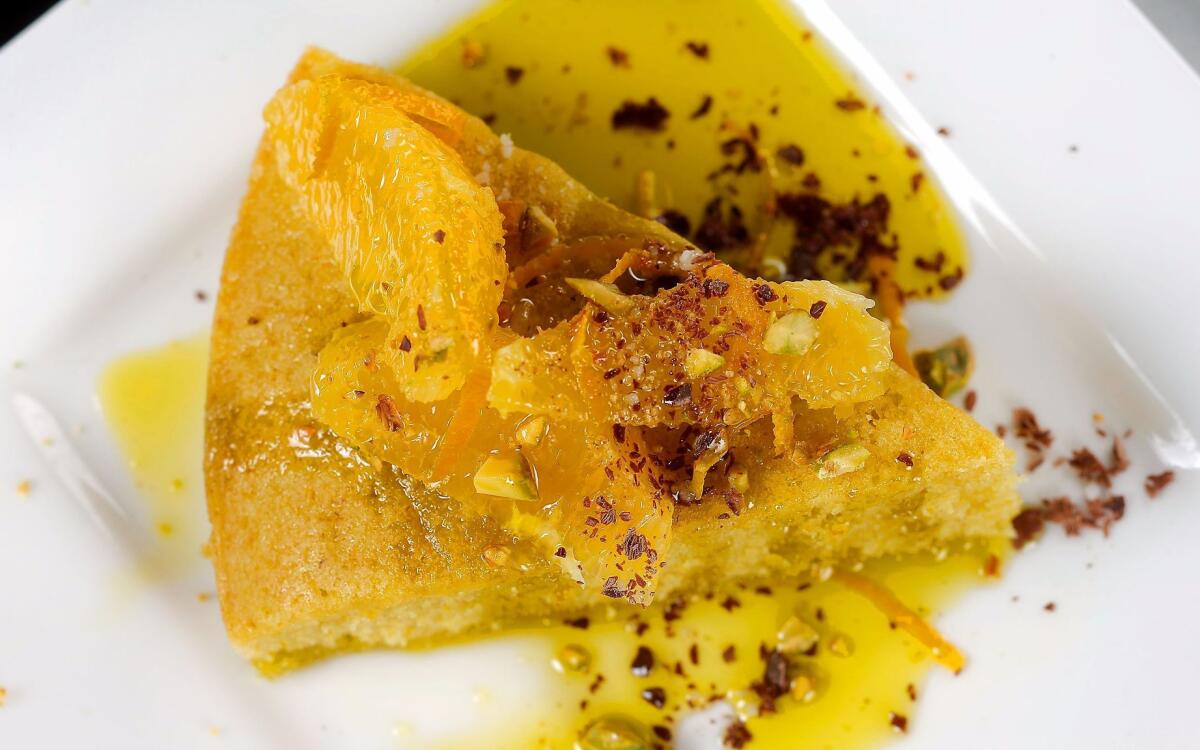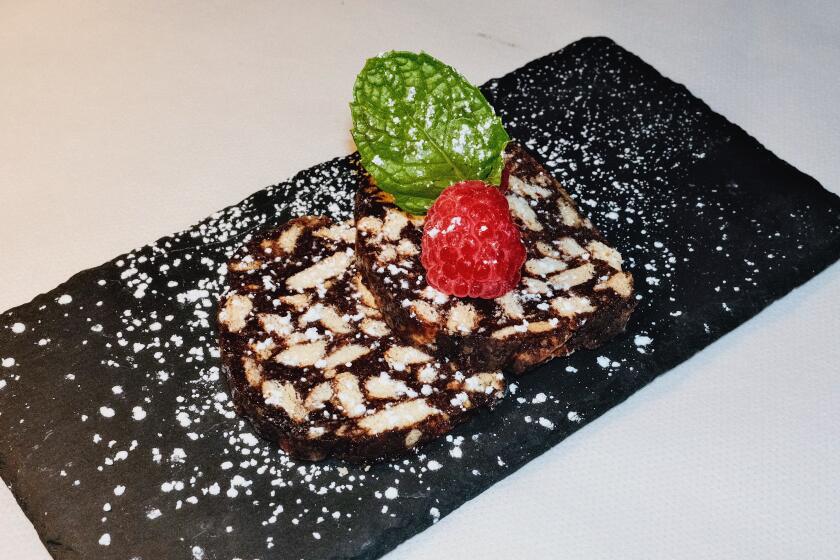Orange and olive oil semolina cake with pistachios, chocolate and olio nuovo

- Share via
Jews have long celebrated Hanukkah by deep-frying pastries — Iraqi zengoula, Indian jalabi, Spanish and Mexican buñuelos, Italian frittelle, Israeli sufganiyot — and pan-frying potato latkes. But it’s the oil — specifically olive oil — and not the cooking method that’s commemorated during the festival of lights.
And the moment olive oil aficionados wait for all year is the release of olio nuovo, the ultra-green first bottling of the year’s first pressing. Skimmed from the vat before the sediment has settled, olio nuovo has a creamy texture and heightened notes of fruit, grass and pepper. As with the Hanukkah oil, olio nuovo is a fleeting ritual, best savored within a few weeks of its release.
December is peak time for new oil, and a number of Los Angeles chefs and stores, from Eataly to Costco, are showcasing the freshly-milled oils from Italian and California producers, making olio nuovo a symbolically and seasonally perfect Hanukkah ingredient — and not a bad holiday gift. (Other oil-producing countries don’t export much of the new oil.)
Olio nuovo “is the first expression of the olive harvest,” says Albert Katz, producer of award-winning olive oil in eastern Napa County and a co-founder of the California Olive Oil Council.
“There is nothing like the first few days of pressing — that rustic, green, unfiltered oil; those first fresh, fruity, intense, viscous drops,” says Katz. Most of the pressing will be left to settle and mellow for several weeks, then “racked off” from perishable solids before bottling to become shelf stable. “After that,” Katz says, “it’s just good oil.”
The best oils are estate-grown, with fruity, bitter and pungent flavors. There are three styles — light, medium, robust — determined by olive varietals, where and how they were grown, when harvested and the miller’s preferences.
Appreciation for olio nuovo in the U.S. is due in large part to Rolando Beramendi, founder of Manicaretti, importer of Italian delicacies, who first introduced the Tenuta di Capezzana from Tuscany to influential California chefs Judy Rogers, Paul Bertolli and Nancy Silverton in the early 1990s.
You can find bottles of olio nuovo at Monsieur Marcel at the Original Farmers Market, L.A.’s recently opened Eataly, if you’re lucky at your local farmers market — even at Costco. (It’s often pricier than other olive oils; and imported are typically more expensive than domestic.)
Once you open your bottle, “use immediately; pour abundantly,” Beramendi writes in the cookbook “Autentico: Cooking Italian, the Authentic Way,” published in October. And keep dishes simple to showcase the oil; olio nuovo can elevate whatever you started with into something transcendent. (Think: spaghetti aglio e olio.)
Maybe the purest taste experience is on grilled bread, with just a sprinkle of good salt. Instead of chopped liver, begin your Hanukkah festivities with crusty bread and olio nuovo.
If you want something a little more involved than bread and oil, boiled potatoes dressed up with parsley, vinegar, pepper and olio nuovo can become a substitute for latkes. The oil makes a terrific finish to a pot of bean and escarole soup. And then there is olive oil cake, made with semolina and oranges and finished with pistachios and chocolate — and more olio nuovo.
So this year, don’t fry all the Hanukkah oil. The method may have changed — neither people nor animals power the mill — but winter’s oil production is essentially the same as in ancient times: crush, press, separate. Now, that’s something to celebrate.
Two upcoming Los Angeles olio nuovo events:
Nancy Silverton is celebrating the launch of Rolando Beramendi’s “Autentico: Cooking Italian, the Authentic Way” (St. Martin’s Press, 2017), with a lunch featuring olio nuovo at noon Dec.10 at Chi Spacca. 6610 Melrose Ave, Los Angeles,(323) 297- 1133, chispacca.com.
Akasha Richmond of AR Cucina is featuring Sicilian olio nuovos throughout the season, including Hanukkah specials and a Christmas Eve Feast of Seven Fishes. 9531 Culver Blvd., Culver City, (310) 558-8800, arcucina.com.
Italy
Tenuta di Capezzana. Region: Carmignano, Tuscany. Olive cultivars: Moraiolo, Frantoio, Pendolino, Leccino. Grassy, “spring in a bottle,” elegantly robust, marries instantly and harmoniously with food. About $50-$55 for 500 ml. Monsieur Marcel, Cheese Store of Beverly Hills, Bay Cities Italian Deli, www.markethallfoods.com
Marchesi de’ Frescobaldi Laudemio. Region: Florence, Tuscany. Olive cultivars: Frantoio, Moraiolo, Leccino. Brilliant green; floral, wheat and artichoke aromas; “grand Tuscan” robust bitterness and pepper. $50-$55 for 500 ml. Monsieur Marcel, www.markethallfoods.com.
Gianfranco Becchina Olio Verde Novello. Region: Belice, (western) Sicily. Olive cultivar: Nocellara del Belice. Intensely green; herbaceous; medium bitterness, spice and pepper; hint of nuts. $45-$50 for 500 ml. www.markethallfoods.com.
Titone. Region: Trapani, Sicily. Olive cultivars: Nocellara del Belice, Cerasuola, Biancolilla. Rich, nutty, herbaceous, fruity, medium pepper. $35-$40 for 250 ml. Mozza2Go, Monsieur Marcel, www.markethallfoods.com.
California
Bondolio. Region: Winters, Yolo County. Olive cultivars: Nocellara, Biancolilla, Cerasuola. Softer Sicilian style, nutty, hints of sweetness, fruit forward, floral, gentle pepper, medium blend. $32-$35 for 500 ml. We Olive stores under the We Olive label, www.bondolio.com and www.markethallfoods.com.
Katz Organic December’s New Oil. Region: Suisun Valley, Napa County. Olive cultivars: Leccino, Frantoio, Maurino. Tuscan-style, medium-bold, golden green, brash and daring, spice, herbs, pepper, artichoke, hint of nut. $25 for 375 ml. Monsieur Marcel, www.katzfarm.com, www.markethallfoods.com.
Seka Hills Estate Olio Nuovo. Region: Yocha Dehe Wintun Nation, Brooks, Capay Valley. Olive cultivar: Arbequina. Very approachable, fresh, bright, grassy, delicate pepper. $16-$20 for 250 ml. Monsieur Marcel, www.sekahills.com, www.markethallfoods.com.
California Olive Ranch Limited Reserve and Olio Nuovo. Region: primarily Yolo and Butte Counties. Limited Reserve: Olive varietals: Koroneiki, Arbequina. Producer describes notes of pear, tropical fruits, and green grass. $19.99 for 500 ml. exclusively online at californiaoliveranch.com. Olio Nuovo: Olive cultivar: Arbequina. Medium intensity, hints of green banana. $10.99 for 1 liter. Los Angeles and other select Costco regions.
Amelia Saltsman is the author of “The Seasonal Jewish Kitchen” and “The Santa Monica Farmers’ Market Cookbook.”
Heat oven to 350 degrees. Oil a 9-inch round baking pan and line the bottom with a round of parchment paper.
In a large bowl, sift or whisk together the flour, semolina, baking powder, salt and pepper.
In the bowl of a stand mixer, or in another large bowl, place the sugar. Very finely grate the zest of 3 of the oranges and add to the sugar, working over the bowl to catch any spray of citrus oil. Using a muddler or the back of a wooden spoon, mash together the sugar and zest until the sugar is moist and tinted pale orange and set aside. Juice 1 of the oranges and set aside.
Using a stand mixer fitted with the paddle attachment, or an electric mixer, beat the olive oil with the sugar-zest mixture over medium speed until well-blended. Add the eggs, one at a time, and beat just until the mixture is creamy. Beat in 1 tablespoon of orange juice and 1 teaspoon orange blossom water. On low speed, add the flour mixture in three batches, beating until just blended; be careful not to overbeat.
Pour the batter into the prepared pan. Bake the cake until the top is pale golden and springs back to the touch, and a toothpick inserted into the center comes out clean, 20 to 30 minutes.
Set the pan on a wire rack and cool for 5 minutes. Run a thin-bladed knife around inside edge of pan and turn out the cake onto rack to cool. Invert the cake onto a serving platter and wrap tightly until ready to serve. The cake may be made up to 1 to 2 days ahead. Wrap well and store at room temperature. (The cake can also be made and frozen, tightly wrapped, up to 2 weeks ahead.)
Prepare the orange garnish for the cake (this can be done up to a few hours before serving): Using a 5-hole zester, remove the zest from the remaining orange in long strands, allowing them to fall into a bowl as you work.
Peel and segment the 3 oranges: Slice the top and bottom off of the oranges, exposing the flesh. Stand the fruit on one end and shave off the peel and pith, tracing the curve of the fruit with your knife and rotating the orange after each cut. Stand the fruit on its opposite end and remove any additional peel and pith. Hold the fruit in one hand over the bowl and slice along both sides of each segment to free it from the membrane, dropping the segments into the bowl with the zest. Squeeze the membrane to extract juice. Stir in the reserved juice and remaining 1 teaspoon orange blossom water.
To serve the cake, spoon orange segments and juice over each slice. Top with pistachios, and a pinch of pepper. Drizzle olio nuovo over, then shave chocolate over using the large holes of a cheese grater. Alternatively, serve the cake plain and pass the topping components for the guests to garnish the slices themselves.
Get our Cooking newsletter
Get a taste of Los Angeles — and the world — with recipes and kitchen tricks from the L.A. Times’ Cooking newsletter.
You may occasionally receive promotional content from the Los Angeles Times.















